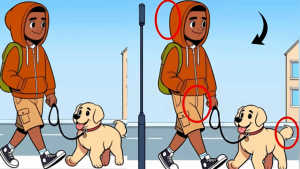Have you ever wondered why spotting differences between two similar images is so addictive? Our minds are natural pattern-seekers, constantly scanning our environment for inconsistencies and changes.
These visual challenges aren’t just entertaining time-wasters. They actually serve as powerful brain workouts that sharpen our cognitive abilities in ways we might not realize.
Daily routines often lead us into mental ruts where observation skills become dulled. When we perform the same tasks repeatedly, our brains shift to autopilot mode.
Visual puzzles provide the perfect solution to this problem. They effectively wake up dormant neural connections and force active processing rather than passive recognition.

The Science Behind 5-Second Challenges
What makes these quick-fire challenges particularly effective is the element of time pressure. When given just five seconds to process visual information, our brains must work with remarkable efficiency.
These rapid-processing exercises activate the visual cortex differently than casual observation does. The time constraint creates a mild stress response that enhances focus.
Research indicates that this combination of novelty and urgency creates ideal conditions for mental sharpening. Think of it as high-intensity interval training for your brain!
Your visual processing systems must operate at maximum capacity when faced with these challenges. This heightened state improves overall cognitive function over time.
How Your Brain Processes Visual Information
Our eyes don’t simply take photographs of what we see. The visual processing system is incredibly complex, involving multiple brain regions working in coordination.
When viewing seemingly identical images, your occipital lobe works overtime. It must process both pictures simultaneously while making rapid comparisons.
Factors like lighting, position, and context all influence how effectively we detect differences. Your brain prioritizes certain visual elements over others based on evolutionary importance.
This prioritization explains why some differences jump out immediately while others remain frustratingly hidden. The more you understand this process, the better you’ll become at these challenges.
Today’s Visual Challenge: The Walking Child
In our featured puzzle today, you’ll see two nearly identical images of a child walking. Your task seems straightforward: identify three distinct differences between these images in just five seconds.
Most people instinctively scan the entire image at once—a strategy that rarely works well. Success comes from systematic scanning of specific elements like clothing, background details, and positioning.
Even individuals with exceptional eyesight often miss at least one difference. This isn’t about visual acuity but rather how our brains process information under time constraints.
The most successful puzzlers develop a methodical approach rather than relying on random scanning. They’ve trained their brains to notice subtle inconsistencies almost immediately.
The Three Hidden Differences Revealed
If you’ve attempted the challenge, let’s review what you might have missed. The three key differences in this particular puzzle are quite subtle:
- The lower portion of the child’s jacket differs slightly between images.
- The dog’s tail position shows variation in shape and angle.
- The child’s jacket cap appearance exhibits minor differences.
Finding all three within five seconds places you in an elite category of visual processors! Only about 1% of people achieve this feat on their first attempt.
Don’t worry if you missed some—these challenges are intentionally difficult. With practice, your brain develops more efficient scanning patterns and recognition abilities.
Optical Illusion Answer

Benefits Beyond Entertainment
These visual puzzles offer far more than simple amusement. Regular engagement provides several substantial cognitive benefits that extend into everyday life.
Your attention to detail becomes noticeably sharper—particularly valuable in professional settings where precision matters. Many people report improved focus in other tasks after practicing these challenges.
The pattern recognition capabilities you develop help form connections that might otherwise go unnoticed. This skill transfers to problem-solving in completely unrelated areas.
Perhaps most importantly, these exercises promote cognitive flexibility—the ability to shift perspectives and approach problems from different angles. This adaptability represents one of the most valuable mental skills in our rapidly changing world.
Brain Health and Visual Challenges
Neuroscientists have discovered that these types of puzzles may actually strengthen neural connections. These reinforced pathways contribute to better memory and enhanced processing speed.
Some research suggests regular engagement might even help delay cognitive decline as we age. The “use it or lose it” principle applies strongly to brain function.
The visual discrimination skills developed through these challenges support reading comprehension and information processing. Students who regularly practice similar puzzles often show improved academic performance.
These benefits accumulate over time with consistent practice—even just a few minutes daily can yield noticeable improvements within weeks.
Why Some People Excel While Others Struggle
Fascinating patterns emerge when studying how different individuals approach these challenges. Some people naturally spot differences immediately, while others consistently struggle despite perfect vision.
Several factors influence performance, including previous experience with similar puzzles and natural attention to detail. Even personality traits like patience and methodical thinking play significant roles.
Those with artistic backgrounds often perform exceptionally well due to their trained eye for visual elements. Years spent analyzing compositions and details create advantages in these tasks.
Age also impacts performance in surprising ways. While conventional wisdom might suggest younger people would excel, middle-aged adults often outperform both younger and older groups due to their combination of processing abilities and life experience.
Training Your Brain to See More
If today’s challenge proved difficult, don’t be discouraged! Visual processing is a skill that improves dramatically with practice and proper technique.
Try practicing “soft focus” methods that allow you to see the overall picture rather than fixating on specific details. This technique often reveals differences that remain hidden during intense concentration.
Work on developing efficient visual scanning patterns that methodically cover entire images. Many successful puzzlers start at one corner and work systematically across the picture.
Compare specific elements between images rather than trying to process everything simultaneously. Check all clothing items first, then background elements, then facial features.
Creating Your Own Visual Challenges
Want to take this further? Consider creating your own spot-the-difference challenges to share with friends and family. This creative process develops both analytical and artistic thinking.
Modern smartphones make this surprisingly easy—simply take two similar photos with subtle planned changes between them. These personalized challenges often prove more engaging because they feature familiar settings.
The process of designing these puzzles helps develop your creative thinking skills while providing entertainment for others. You’ll gain appreciation for what makes an effective visual challenge.
As you become more experienced, you can increase the subtlety and complexity of the differences you create. This progression challenges both creator and solver in new ways.
Incorporating Visual Puzzles Into Daily Life
You don’t need special equipment or significant time investment to reap the benefits of these brain exercises. Simple integration into your routine works best.
Start your morning with a quick spot-the-difference challenge instead of immediately checking emails. This mental warm-up prepares your brain for the day ahead.
Use short breaks during your workday for quick visual puzzles rather than scrolling social media. Even 30-second challenges provide cognitive benefits and mental refreshment.
The key is consistency rather than duration. Brief daily practice leads to cumulative improvements in visual processing and overall cognitive function over time.
The Future of Visual Puzzles in Cognitive Science
As our understanding of brain health advances, these simple visual exercises gain recognition in scientific communities. Researchers explore applications ranging from attention disorders to early-stage cognitive decline prevention.
Forward-thinking companies have begun incorporating similar visual exercises into employee wellness programs. They recognize the potential workplace benefits of improved attention and visual processing.
Digital platforms now offer increasingly sophisticated versions of these challenges with adaptive difficulty levels. These programs adjust to your abilities, providing optimal challenge as you improve.
What once seemed like simple entertainment now represents an intriguing intersection of gaming and brain science—a simple activity with potentially profound cognitive rewards.
FAQs About Optical Illusion Challenges
Why do some people spot differences faster than others?
Individual differences in visual processing speed, attention patterns, and prior experience all contribute to performance variation.
Can these exercises really improve brain function?
Research suggests regular practice with visual puzzles enhances neural connections associated with attention and visual processing.
How often should I practice these visual challenges?
Even 5 minutes daily can yield benefits; consistency matters more than duration.
Do these skills transfer to real-world tasks?
Many professionals in fields requiring attention to detail report improvements in work performance after regular practice.
Are digital or printed visual puzzles more effective?
Both formats provide similar cognitive benefits; the most important factor is regular engagement rather than the medium.
Can children benefit from these puzzles?
These activities strongly support the development of attention skills and visual discrimination abilities in developing brains.
What if I never improve at these challenges?
Everyone improves with practice, though individual baseline abilities and rates of improvement vary considerably.
Are there specific techniques to get better at these puzzles?
Systematic scanning, soft focus techniques, and comparing similar elements between images all improve performance.
Can these exercises help with reading difficulties?
Some research suggests visual discrimination exercises may support certain aspects of reading skill development.
Is there an optimal time of day to practice visual puzzles?
Many people find their visual processing sharpest in mid-morning, though individual peak performance times vary.
